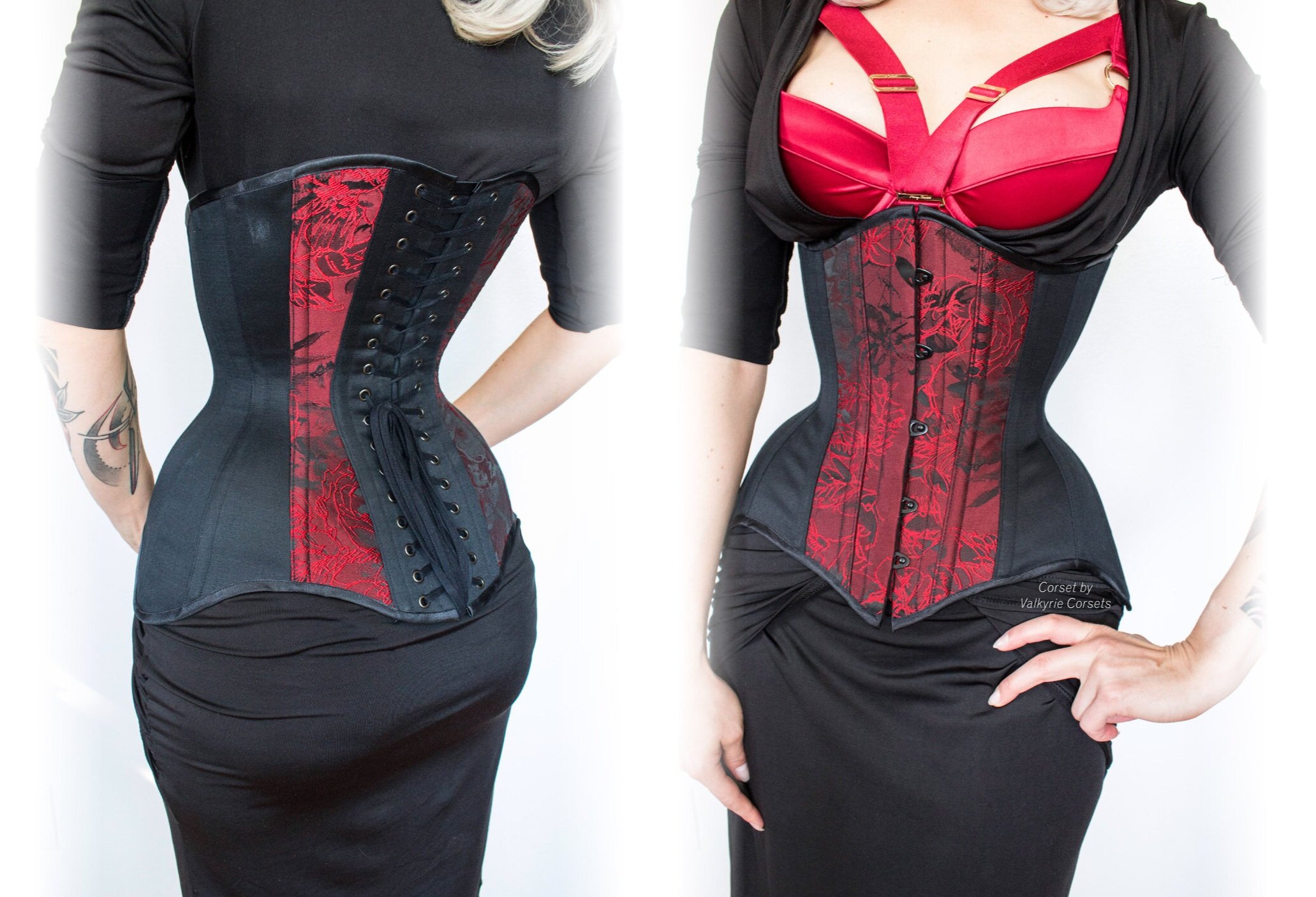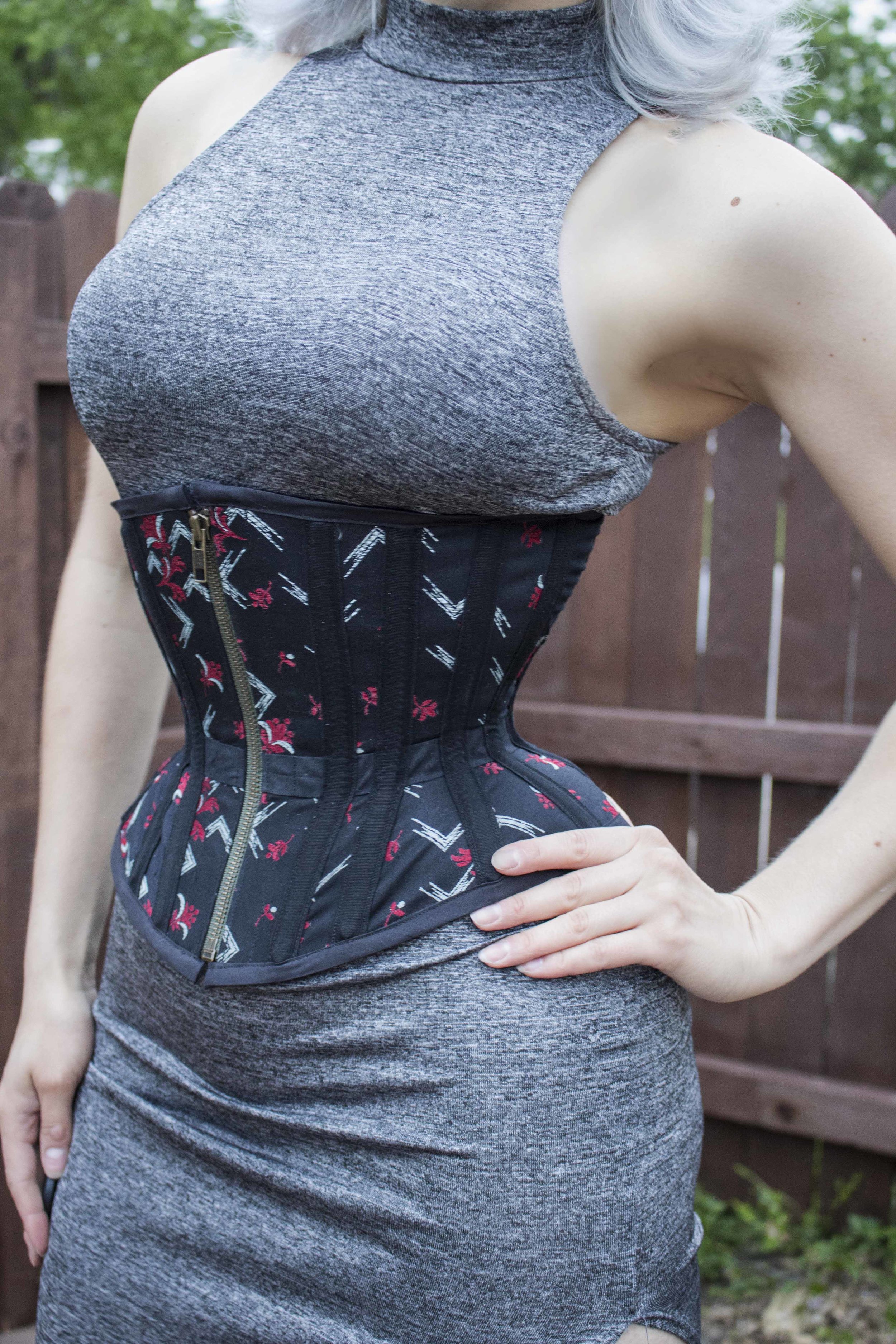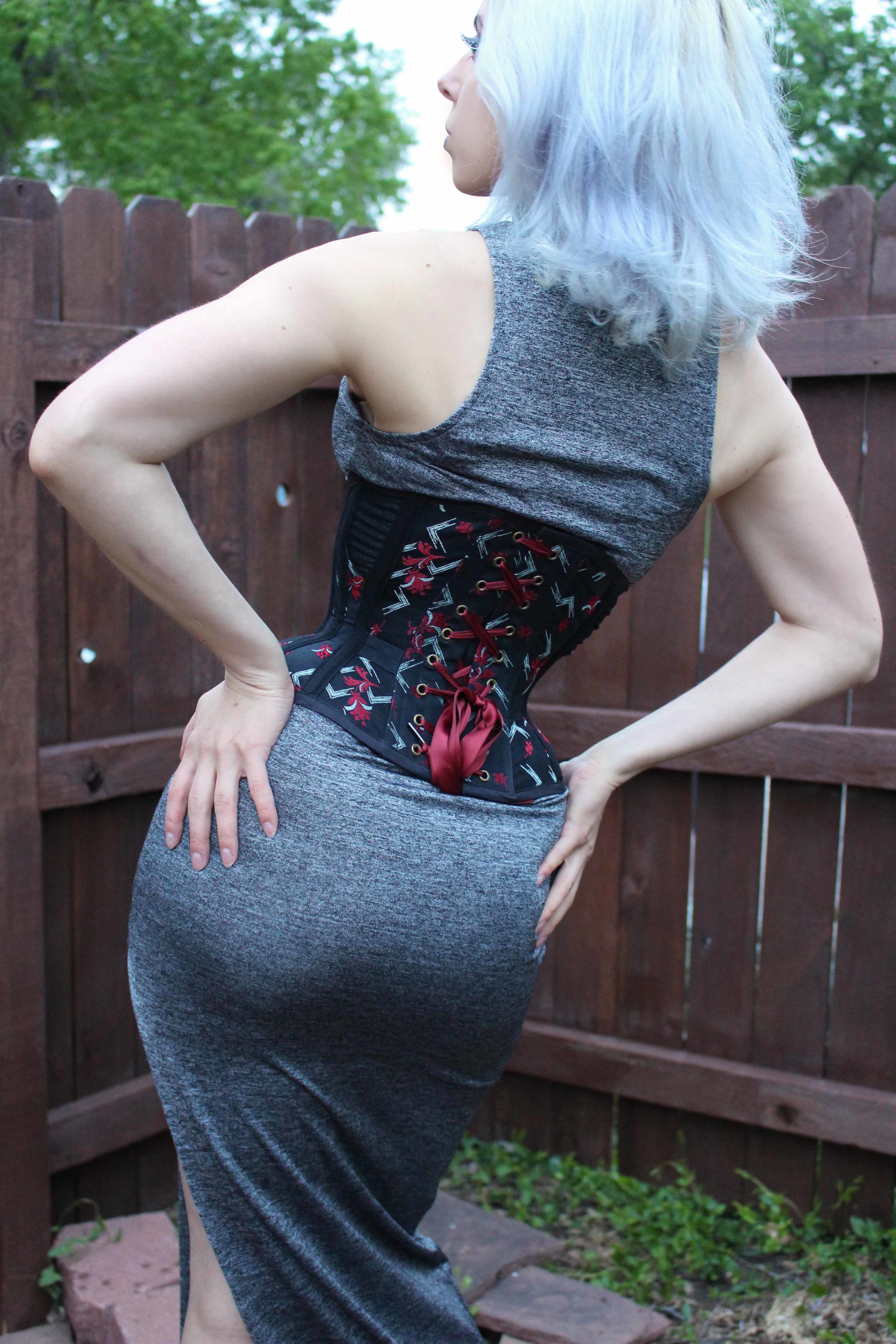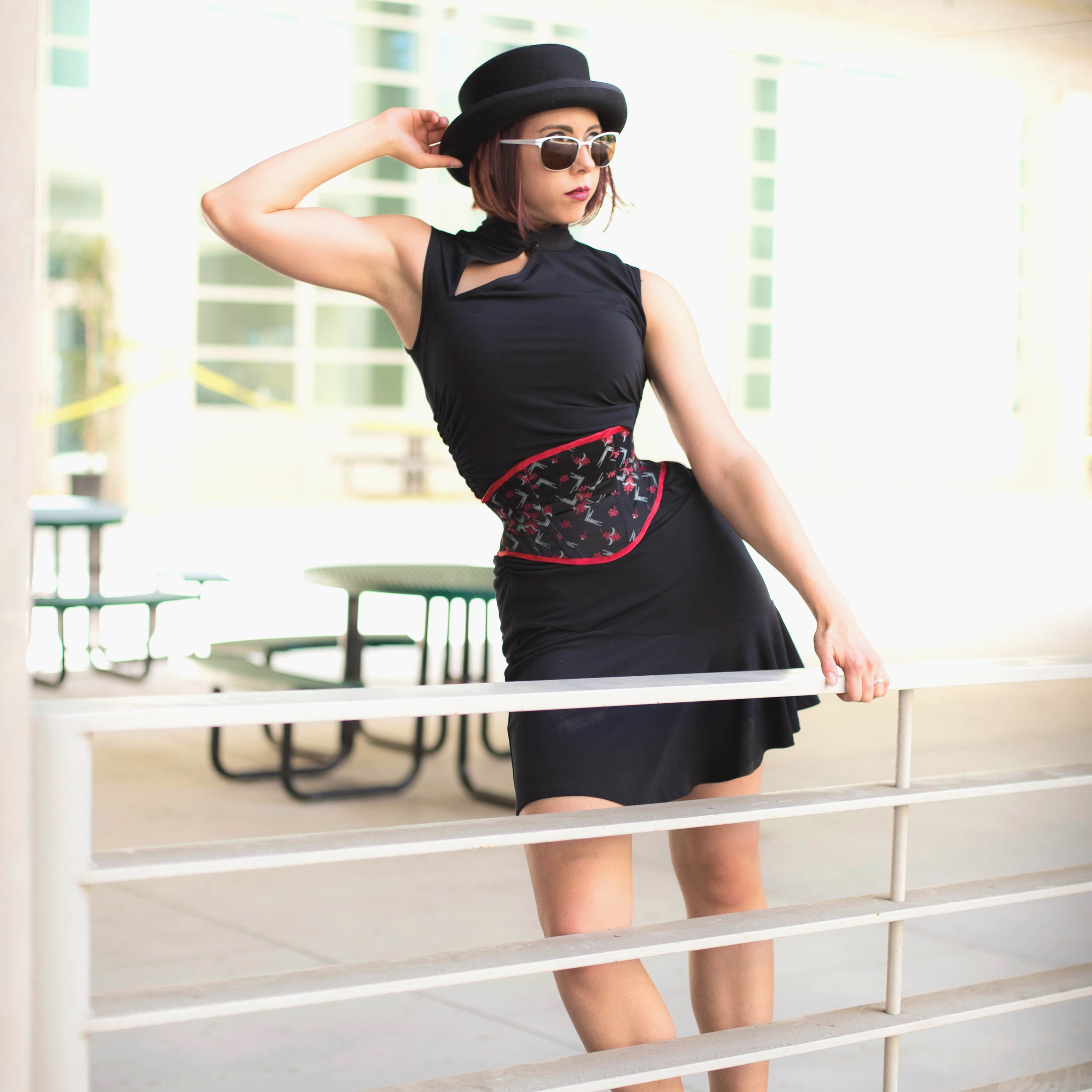I want to start waist training. Help!
Corset by Valkyrie Corsets | Styling, Model: Strait-Laced Dame Corsetry
“How do I start waist training?”
This is the most common question that I receive from people when I discuss corsets. So if you are interested in learning more about “waist training” or “corset training”, you are not alone - and you’ve come to the right place!
Here, I’ve complied an overview of some of the most important aspects on getting started in waist training with a steel-boned corset. This guide may not be all inclusive, but it is guaranteed to give you a good place to start.
What is waist training?
Before reading on, let’s make sure that we are all on the same page when using the term “waist training”. In the context of all articles produced by Strait-Laced Dame, waist training refers to the use of a quality steel-boned corset for the purpose of modifying the shape of one’s body, in either a permanent or semi-permanent manner. This can include a reduction in the waist circumference, an increase in the flexibility of one’s lower ribs, a redistribution of body mass, or the ability to tolerate greater reductions in a corset.
Please note that this guide, and all other discussions of waist training on this site do not apply to fajas or elastic/latex waist cinchers. In general, if steel boning is not used in the corset (with the exception of synthetic whalebone), it is not suitable for waist training.
Keep in mind that you can still wear a corset without the intention of waist training! A well-made corset can flatter the figure or offer back support, all without any long-term changes to the body. However, waist training differs from regular corset wear or occasional tight-lacing in that waist training is a form body modification. Because of this, waist training must be approached carefully to be able to experience results in the safest, most effective way possible.
Waist training with a steel-boned corset takes patience and commitment. Do not try this if you are unwilling to invest effort, time, and financial resources. This is not a low-cost hobby. Functional waist training corsets can range from affordable to very expensive, but useful corsets for this application are never “cheap”.
Photography, Corset, Styling: Strait-Laced Dame Corsetry
How does waist training work?
Sometimes it is easier to point to success stories than provide explanations as to why waist training with a steel-boned corset works. Here we will touch on some of the more likely reasons that you might see a change in your body when waist training. Keep in mind that this is a very basic, very watered-down overview of the mechanics of waist training.
Links to videos produced by Lucy’s Corsetry are provided below, if you would like to hear more about the physical effects of waist training.
Rib Recontouring/Flexibility. A corset should not be compressing any other bones than those in your ribcage. If undue pressure is being placed on your spine or hips, then the corset being used is either made poorly or is a poor fit for your body. Even when compressing the ribs, only the “false ribs” (the lowest ribs, connected to the spine and/or sternum by soft, flexible cartilage) are usually affected. These bones already expand and contract with each breath, and they can easily accept a small amount of pressure from a well-fitted corset. With time and consistency in waist training, these lower ribs (usually the lower 5 pairs) can become increasingly more flexible, thus allowing you to cinch tighter without any discomfort.
Lucy’s Corsetry: Corsets and your Bones
Muscle Morphology (Shape). Since your muscles are comprised of living, growing, constantly-regenerating tissues, they have the potential to grow longer and more flexible with time and training. The effect of waist training on the core muscles can be similar, generally encouraging the muscles, most notably the obliques, to match the shape of the corset. With long-term waist training, these changes in muscle shape can last after the corset is removed.
Lucy’s Corsetry: Corsets and Your Muscles
Adipose (Fat) Tissue Movement. Much like lean tissue, body fat is living, and even in a person who maintains their weight, it can fluctuate in microscopic ways. There are theories that compression placed on the waist can discourage the fat cells in that area from absorbing nutrients, thereby leaving the individual fat cells smaller, or, “more empty”; and allowing those nutrients to be absorbed by cells elsewhere in the body. However, I have found little evidence, beyond anecdotal cases, to support this hypothesis. You may or may not find that something like this happens in your own case, but there is certainly no guarantee.
Reduced Stomach Capacity. A corset really does act somewhat like an external “lap band”, compressing your stomach just enough to discourage you from overeating to the point discomfort. This means that, if you leave your corset on while eating, you will feel fuller sooner. It’s entirely possible to maintain weight while wearing a corset, but waist training can also encourage you to eat more mindfully. Of course, taking a corset off mid-meal to make room for more will eliminate this potential benefit!
Internal Organ Repositioning. We are so quick to forget the rigors that the human body is designed to handle, especially pregnancy. While this example is more relevant for females than males, it’s important to understand that internal organs are made to be somewhat flexible in all humans. For women, this is clear in how a developing fetus can trigger the movement of the organs in the abdominal cavity. When engaging in waist training with a steel-boned corset, there is some very minor movement, mostly in the lower digestive tract (the intestines).
Lucy of Lucy’s Corsetry also points out that the stomach, liver, and spleen are affected. These organs, too, are well-adapted to modest repositioning within the human body. (Remember, your soft meat bits are not being crushed!) As you progress in waist training, you may notice that a corset begins to feel slightly looser after a few hours of wear. This is generally due to the stomach or intestines settling either above or below the corseted waist, thus reducing the internal pressure at the waistline. It is not at all harmful when a proper corset is used, but is a great demonstration of the internal flexibility of your body.
Lucy’s Corsetry: Corsets and your Organs
Fluid Reduction (Temporary). You may experience a reduction of fluid held in any part of the body where compression is applied. This is a well-documented bodily function, and the reason behind using compression bandages on swollen or injured muscles. Applying even slight pressure to the torso with a well-made corset encourages the release of fluids from abdominal tissues, thus temporarily reducing the size of one’s waist. Be careful not to mistake this as a long-term effect of waist training. When the corset is removed, fluids are likely to move back into the site from which they were just ushered away.
Photography and Retouch by Black Brush Photography | Corset by Lovely Rats Corsety | Styling, Model: Strait-Laced Dame Corsetry
Choosing Your First Corset: Quality
When choosing your first waist training corset (or any corset after that) you need to consider the quality of the garment. A corset made for waist training must meet a few minimum criteria to be suitable for daily use at even a moderate waist reduction. Carefully read through the specifications shared by a corset maker or corset seller to determine if it meets these standards. If it is not listed, ask before purchasing.
Steel Bones. These pieces of metal may be either flexible spiral steel or flat steel “bones”. Verify with the seller or maker that the bones are tipped or dipped to prevent them from damaging the fabric or poking through the boning channels in the corset. Plastic boning of any kind is unacceptable for waist training, with the only exception being synthetic whalebone.
Waist Tape. A piece of herringbone tape (or “ribbon”) should be sewn into the corset at the smallest part of the waist, running around the entirety of the waistline. This keeps the corset from stretching out over time. The waist tape may be sewn into a corset between layers of fabric so that you cannot see it.
Strength Fabric. For a corset to hold up to the rigors of waist training, it must be made with a sturdy, non-stretch, tightly-woven fabric for at least one of its layers. Herringbone coutil is the most commonly-used strength layer in corsets. Some heavy-duty sports mesh corsets can also work for waist training, but the entire corset should never be a stretchy material if the goal is waist training.
Metal Grommets. These grommets or eyelets should be located on either side of the corset in the back at the lacing gap. Each set of grommets should be reinforced by steel bones on both sides to prevent the lacing gap from buckling or curving when the corset is tightened. If the corset is tightened without using a grommet-and-lacing system (such as with hook and eye closures) it is unsuitable for waist training. Also, be skeptical of any corset which is shown with a bowed-out lacing gap on the model or dress form in photographs; this shows a lack of rigidity in the back boning, which will generally make it less comfortable to lace up or wear.
Silhouette. The overall shape of a corset must be made with a pattern that comfortably contours your body. There is no single silhouette (examples: hourglass, conical, s-curve) of corset that is best for everyone. However, there are some shapes that should be avoided by anyone attempting to waist train. Stay clear of any corset which appears “tubular” in shape - that is, corsets which show very little curve in the waist. Corsets like this will not provide any real reduction to your waist, and you are unlikely to achieve any lasting waist training results.
Underbust vs. Overbust. Keep in mind that it is also recommended that you use an underbust, not an overbust, corset as your first waist training corset. An underbust corset will not rise past your breasts or pectorals, and will maintain the necessary pressure on your torso for effective waist training without limiting your range of motion any more than necessary. Overbust corsets are not intrinsically bad, but they are not generally an ideal choice for your first waist training corset. Try an underbust first for the most comfortable introduction to waist training.
Photography: Kathy Hoos | Corset, Styling: Strait-Laced Dame Corsetry
Choosing Your First Corset: Size and Measuring
Even if a corset exceeds all of the suggested criteria for quality, if it doesn’t fit your unique figure, it will not be suitable for your waist training goals. Some of us are taller or shorter, some of us are more or less curvy, and even then, not everyone’s curves are in the same places!
There are more measurements to consider than just your waist size when picking out the best-fitting corset. Since a corset is such a close-fitting garment, it is vital to consider your hips, ribs, and more. Be sure to consult the corset maker or corset seller to verify that the corset you choose will fit you in all the right places.
Start with these basic measurements for standard-sized OTR corsets, using a flexible measuring tape to take them. You can provide more measurements if requested by your corset maker or seller.
HORIZONTAL
Underbust. Measure around your torso right beneath your breasts or pectorals, keeping the measuring tape parallel to the floor. For those who wear a brassiere, this will be about where the underwire would sit below the breast. This measurement might also be referred to as the “ribcage” circumference.
Waist. In reference to corsetry, the “waist” is the smallest part of your midsection, often called the “natural waist”. For most, this is one to two inches above the navel, or just below the bottom of your lowest ribs. To find your natural waist, gently wrap the measuring tape around your torso and try to seat it into the narrowest part of your waist by bending slightly from side to side. If you have trouble finding your natural waist, simply take your circumferential measurement at the point one inch above your navel.
High Hip. Palpate the side of your hips with your hands to try and locate your pelvis. Take note of where the top of your pelvis is. This is where the “high hip” or “iliac crest” measurement is taken. For some short waist cinchers, this is where the bottom edge of the waist training corset will end. Wrap the measuring tape around your torso where you located the top edge of your pelvis, keeping the tape parallel to the floor.
Mid Hip. From your “high hip”, move down about 2-3”, where your pelvis is covered with more soft tissue. For most average-length waist training corsets, this is the bottom edge of the corset. Again, wrap the measuring tape around, keeping the tape parallel to the floor for an honest measurement.
When choosing a waist training corset, it’s also important to consider how long of a torso you have. While some have shorter midsections that would be squeezed uncomfortably in anything but a cincher, others can fit into a longline corset without any trouble. Compare your vertical measurements to those of the corset seller before purchasing, or discuss this with your corset maker if ordering a custom corset.
VERTICAL
Underbust to Waist. After you have identified where your underbust and natural waist measurements are (discussed above), while standing, find the vertical distance between the two. This will determine how high a corset can rise from the waist before it might pinch the flesh of your breasts or pectorals. If a corset rises too high from the waist, it can also interfere with your underwire if you wear a bra. If it does not rise high enough above the waist, you may experience some flesh being squished or spilling over the top edge, which can create a bumpy silhouette.
Waist to High/Mid Hip. Once you have found where your high hip and mid measurements are, while standing, find the vertical distance between each of these and your waist. You can use these measurement to judge whether a corset will extend too low or not low enough below your waist. If a corset ends too far below your waist, it can pinch your hips uncomfortably, potentially even pinching a nerve or temporarily cutting off circulation in your legs. A corset that does not extend below the waist far enough may not give you enough tummy support in the side or front, which can result in a less-smooth silhouette.
Waist to Lap. Sit down for this measurement. Use your measuring tape to find the distance between your natural waist and the top of your thigh, or your hip crease (this is where the skin between your thigh and torso folds when seated). When searching for a corset, look to see that the front-side of the corset will not extend so low as to pinch into your thigh. If a corset is too long in the front-side or center-front, you may find it very uncomfortable to sit. Look for corsets with a bottom edge that curves up and over the thighs in the side-front, designed to give the legs a bit more room when the corset is worn while sitting down.
corset waist size
But what about your corseted waist? What size should you choose to start? There is on universal answer that is appropriate for everyone.
There are quite a few factors which play into how much you can reduce your waist to begin with, the most prominent of which are body composition and overall size. A very lean person will have a much harder time cinching a corset of any type, as bone and muscle have fairly little “give”, especially without previous waist training. However, an individual with more adipose/soft tissue will likely be able to lace up a corset more tightly without feeling that it is too restrictive, as this type of body mass moves with much less resistance than lean tissue.
If two individuals have the same body composition, but one has a natural waist of 22” and the other of 42”, the latter likely to be able to accept a larger corseted reduction to start. Again, this simply has to do with the amount of tissue that can be temporarily displaced with ease by a corset.
A good rule of thumb to start with, is to reduce your waist by about 15% with your first waist training corset. If you are particularly lean, you may wish to reduce by less; if you have a bit more fluff you may be able to comfortably reduce by more. Let’s look at a couple of examples.
A woman with an average body composition and a waist of 33” could easily start waist training with a corset that provides a 15% reduction to her waist.
33 inches x 0.15 = 4.95
Rounding to a reduction of 5”, this suggests that a corset sized to close at 28” may offer the best fit to start with.A lean male with a natural waist of 27” may be most comfortable starting waist training with a corset that reduces his waist by only 10%.
27 inches x 0.10 = 2.7 inches
If we round this to 3”, that suggests that a good corset for him to start with would be sized to 24” when closed.A woman with much more soft tissue and a waist of 50” could probably cinch a corset much more than either of the examples above – likely by as much as 20% to start.
50 inches x 0.20 = 10 inches
For this individual, a corset sized to close with a waist of 40” could be a good choice as a first-time waist training corset.
Sizing Summary
Now that you have gathered these first basic measurements, you can either submit them to your corset maker for your custom corset, or you can start comparing your body to the size charts provided by OTR corset sellers. Take your time in this step. It will pay off for you to be patient and thorough when reviewing size charts. If you are unsure of how to read a size chart, or if you don’t believe that the company has provided enough points of measurement for you to make an accurate judgment of fit, contact the corset seller or maker for more information.
Photography, Corset, Styling: Strait-Laced Dame Corsetry
Additional Information
There is so much to learn about waist training and corsets, and you will come to know much more with time. Most of it is learned through practice, but it is always helpful to have resources at your disposal when questions arise. Feel free to contact me personally at Heidi@straitlaceddame.com.
A Final Note Regarding this Article
The advice offered above is not meant to satisfy the needs and questions of every single person who has considered starting waist training. There are always unique cases where “generalized” information like this does not fit one’s needs. My aim is to provide a basic guide for the majority of people interested in how to get started with waist training using steel-boned corsets. If you feel that I have not offered you the best information for starting off, please don’t hesitate to contact me. Your feedback helps me to offer the best information possible.







